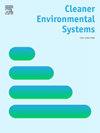Evaluation of the life cycle sustainability of a wastewater treatment plant using the eco-efficiency index for optimizing the energy-economy-environment nexus
IF 4.9
Q2 ENGINEERING, ENVIRONMENTAL
引用次数: 0
Abstract
Despite significant progress in the sustainability of wastewater treatment plants (WWTPs), key challenges remain. This paper assesses the sustainability of a WWTP under various scenarios in Iran, considering different electricity-generating technologies powering the WWTP and sludge management systems. The eco-efficiency (EE) index, combining life cycle assessment (LCA) and economic assessment, is used to assess the energy-economy-environment nexus. The scenarios are based on the electricity sources and sludge management systems of the WWTP. Furthermore, an optimization model is proposed to determine optimal energy tariffs and assess the feasibility of transitioning towards energy self-sufficiency. The results indicate that scenarios utilizing the landfill for sludge management and energy generation have the highest environmental impacts, while the scenario employing wind power and anaerobic digestion (AD) system has the least impact. From an economic perspective, scenarios utilizing AD and selling biogas yield lower profits than the alternatives. Also, the scenario utilizing wind power and compost production from the sludge has the highest sustainability, with an EE index equal to 60.68 $/Pt. Furthermore, the results show that when the tariffs for electricity and heat are 0.86 $/kWh and 0.052 $/MJ, energy production will be economically and environmentally justified. The feasibility assessment suggests that when only the grid electricity option is available, it is preferable for the WWTP to utilize combined heat and power (CHP) systems, enabling it to meet its needs independently and create a benefit. This study provides critical insights for WWTP sustainability, guiding efficient wastewater management practices.
利用优化能源-经济-环境关系的生态效率指数评价污水处理厂的生命周期可持续性
尽管在污水处理厂(WWTPs)的可持续性方面取得了重大进展,但主要挑战仍然存在。本文评估了伊朗污水处理厂在各种情况下的可持续性,考虑了不同的发电技术为污水处理厂和污泥管理系统提供动力。将生命周期评价与经济评价相结合,采用生态效率指数评价能源-经济-环境关系。这些场景是基于污水处理厂的电力来源和污泥管理系统。此外,本文还提出了一个优化模型来确定最优能源电价,并评估向能源自给过渡的可行性。结果表明,利用垃圾填埋场进行污泥管理和发电的情景对环境影响最大,而利用风力发电和厌氧消化(AD)系统的情景对环境影响最小。从经济角度来看,利用AD和销售沼气的方案比其他替代方案的利润要低。此外,利用风能和从污泥中生产堆肥的方案具有最高的可持续性,其EE指数等于60.68美元/铂。此外,结果表明,当电价为0.86美元/千瓦时和电价为0.052美元/兆焦耳时,能源生产在经济和环境上都是合理的。可行性评估表明,在只有并网发电选项的情况下,污水处理厂采用热电联产(CHP)系统,可以独立满足其需求并创造效益。本研究为污水处理厂的可持续发展提供了重要的见解,指导了有效的废水管理实践。
本文章由计算机程序翻译,如有差异,请以英文原文为准。
求助全文
约1分钟内获得全文
求助全文
来源期刊

Cleaner Environmental Systems
Environmental Science-Environmental Science (miscellaneous)
CiteScore
7.80
自引率
0.00%
发文量
32
审稿时长
52 days
 求助内容:
求助内容: 应助结果提醒方式:
应助结果提醒方式:


